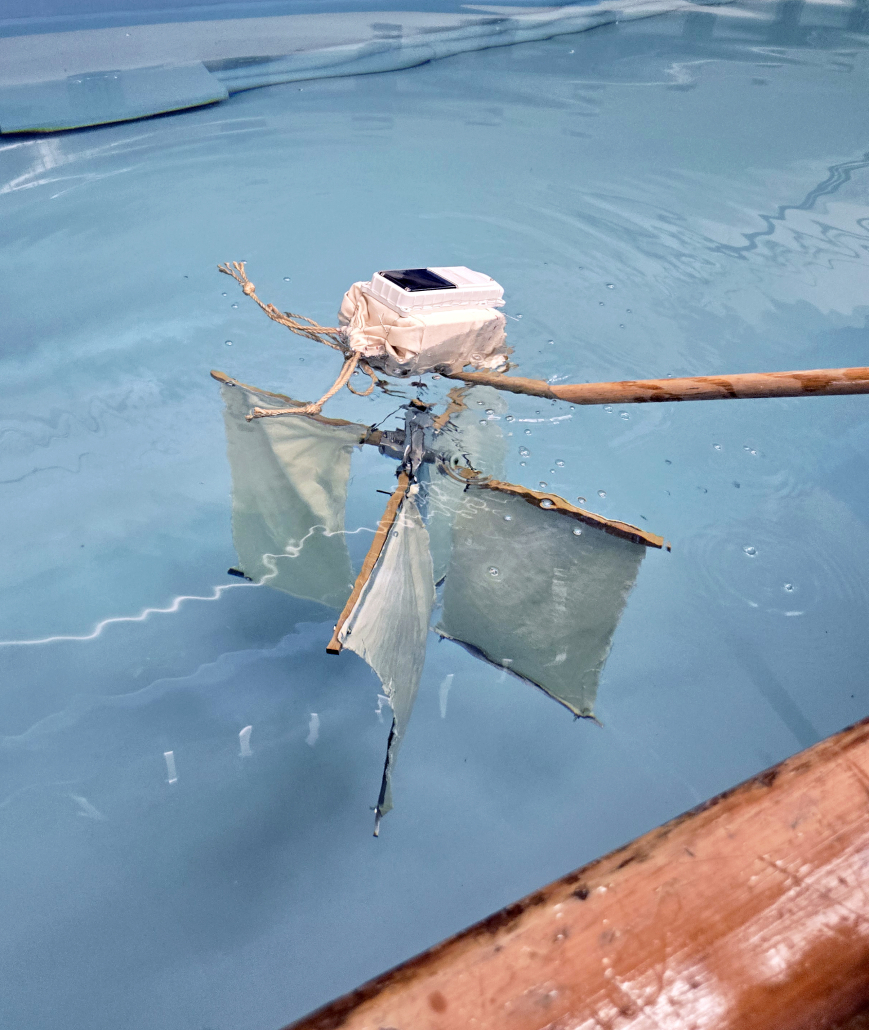Students and Educators Investigate Marine Debris by Building, Launching, and Tracking Drifters
MIT Sea Grant, Stonehill College, and the Cohasset Center for Student Coastal Research activate a collaborative network to track marine debris
Through a collaborative project with MIT Sea Grant, Stonehill College, and the Cohasset Center for Student Coastal Research (CCSCR), a coalition of students, educators, and fishermen are using drifters to investigate marine debris and the path it takes from land to sea. Drifters are devices designed to float near the surface of the water for tracking and study of ocean currents. With funding from the National Sea Grant Infrastructure Investment and Jobs Act (IIJA) Marine Debris Community Action Coalition Competition, the collaborators developed low-cost drifters and engaged local students and educators to explore how marine debris moves in the ocean.
As part of the 2024 pilot cohort, five marine debris drifters were built by classes of K-12 students in Massachusetts and Rhode Island, including the Upper Henderson Inclusion School and John D. O’Bryant School of Mathematics and Science (both part of Boston Public Schools), Codman Academy Charter School in Dorchester, and Blackstone Academy Charter School in Pawtucket, RI.

Two types of drifters were deployed: one made of aluminum spars with a styrofoam buoy for floatation and canvas sails, and the new drifters comprised of sustainable materials including oak, iron, and pumice, a volcanic rock with trapped air bubbles that replaces styrofoam. Each drifter includes a GPS tracker to transmit its course and aid in retrieval, preventing the drifters from becoming marine debris themselves. The drifters were then deployed with the help of local fishermen, and tracked over the course of their voyages.
(Photo credit: Andrew Bennett, MIT Sea Grant)
MIT Sea Grant Geospatial Applications Developer Ben Bray created a marine debris interface using his data visualization framework, Seaglass, to visualize the GPS data from the drifters. This interface provides an interactive tool for students and educators to track their drifters, which have been winding their way into bays and farther out into the Atlantic since their deployment this past spring and summer. They can also visualize ocean properties that relate to the drifter tracks, like currents, sea surface temperature, chlorophyll etc.
>>View the drifters on the marine debris visualization interface
Associate Professor of Environmental Science at Stonehill College Kristin Burkholder, is one of the leads on the project, lending her expertise in physical oceanography and ocean circulation. “The Codman and Blackstone drifters both flow southwestward along the outer edge of Georges Bank before getting entrained into the flow of the Gulf Stream,” Burkholder explains. “Today, the Codman Academy drifter has almost reached Bermuda! It’s pretty amazing!” With the marine debris interface, students have the opportunity to visualize and learn about swirling eddies, currents, and other forces at play. As of mid-February, the five drifters traveled a total of 15,975 miles.
As part of the initiative, more than 115 high school students have participated in events at Stonehill College, where they discussed their research and findings. About 60 third grade students from the Upper Henderson Inclusion School have also participated in mobile events investigating marine debris.
In addition, more than 30 fishermen have contributed to the effort by bringing the drifters out on their vessels for offshore launches. These fishermen have also worked as part of a broader effort, the Student Drifter Program, which extends beyond the work of this grant. Project partners Erin Pelletier, Executive Director of the Gulf of Maine Lobster Foundation, and James Manning, a retired NOAA Fisheries oceanographer, have worked for many years to build relationships with fishing communities. “Most of the fishermen who deploy the drifters are also involved with our Environmental Monitors on Lobster Traps (eMOLT) Project,” says Manning. Jack Buckley, a founding member and President of CSCR, also recruited fishermen to join the coalition.
In 2025, the collaborators anticipate building and deploying another 15 drifters with an expanded cohort of classrooms and educators. MIT Sea Grant Education Administrator Andrew Bennett has developed a new collapsible design so students farther from the coast can build and mail the drifters to volunteers who will take them out for launch. Bennett will be conducting test launches in Buzzards Bay this winter with the updated drifter designs, which will be used by the 2025 cohort later this year.
>>View the drifters on the marine debris visualization interface



